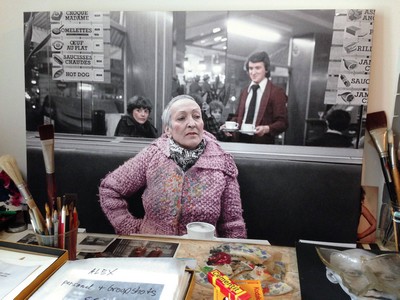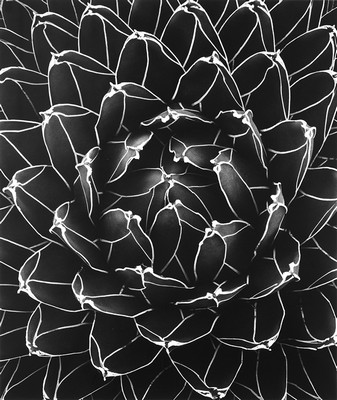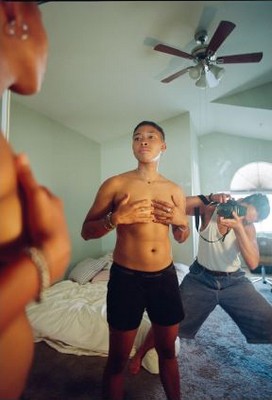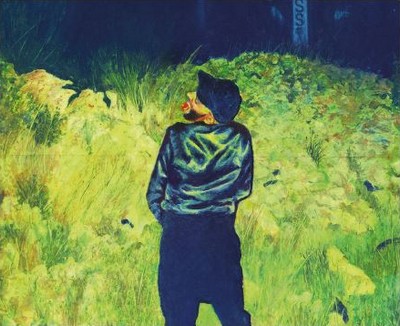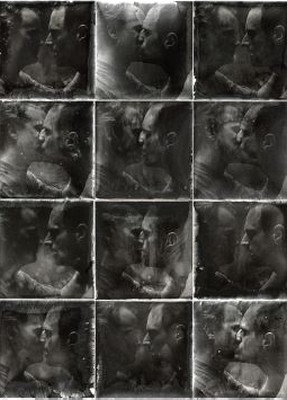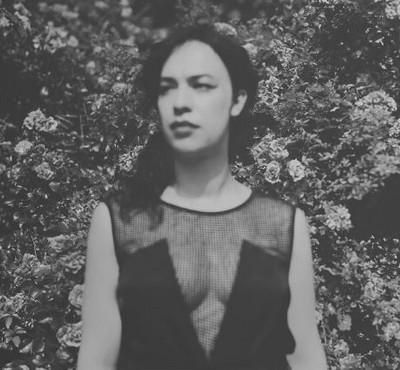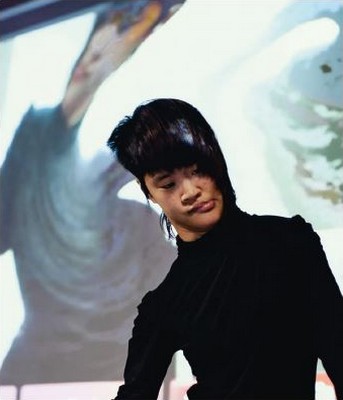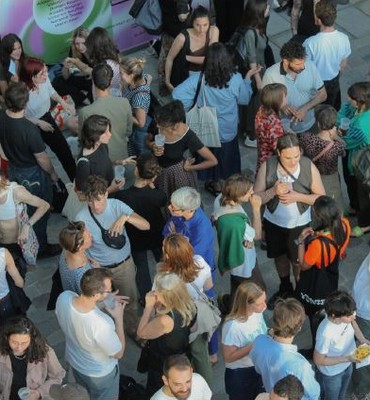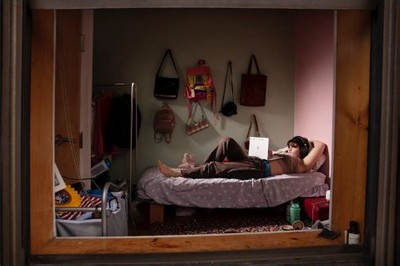This Is New York
100 Years of the City in Art and Pop Culture
Museum of the City of New York
Opens to the public Friday, May 26, 2023
M Train on Route to Manhattan Approaches the Williamsburg Bridge. 1995
Copyright Richard Estes, Courtesy of Louis K. Meisel Gallery
Tempo of the City I. 1938
Museum of the City of New York
Museum Purchase with funds from the
Mrs. Elon Hooker Acquisition Fund, 1940. 40.140.249
Beautiful or menacing…opulent or awful…lively or lonely…fun or frightening…inspiring or irritating…New York City has been a muse for myriad artists over the last 100 years. In celebration of its Centennial, the Museum of the City of New York presents This Is New York: 100 Years of the City in Art and Pop Culture, an interactive and sweeping exhibition examining what NYC has meant to people, including artists, writers, and other creators who have been inspired by the city. The exhibition features more than 400 objects across visual art, television and film, music, theater, literature, and fashion; a digital bookshelf interactive voiced by celebrities such as Matthew Broderick, Rosario Dawson, Lea DeLaria, Tessa Thompson, and more; as well as a must-see immersive film experience highlighting the sights, sounds, and significance of the city in cinema.
“Around the world, billions of people have an idea of what New York City is because they have learned about the city through movies, television, music, literature, photography, and more. The city is an object of perpetual fascination that is interpreted and reinterpreted and continues to inspire creators across different genres,” says Sarah M. Henry, the Robert A. and Elizabeth Rohn Jeffe Chief Curator and Interim Director of the Museum of the City of New York. “In honor of the Museum of the City of New York’s centennial – and to underscore our role as NYC’s storyteller—we’re thrilled to present This Is New York, an exciting new exhibition celebrating the city's vibrant art and pop culture scene over the past century and showcasing works from artists, musicians, and other creators who have helped define the city's cultural identity.”
The exhibition, which takes over MCNY’s entire third floor, features several key sections:
• TEMPO OF THE CITY, which looks at how artists have captured various aspects of joy and struggles evident on the streets of NYC. Some key objects and elements in this section include:
o Berenice Abbott’s Tempo of the City, a black and white photograph from 1938 capturing New Yorkers as they rush around, utterly absorbed in their own daily lives;
o Jimi Hendrix’s handwritten notebook, which includes lyrics for the legendary guitarist’s song, Electric Ladyland (courtesy of the Museum of Pop Culture);
o Homage to the People of the Bronx: Double Dutch at Kelly Street—La Freeda, Jevette, Towana, Staice, a relief sculpture by John Ahearn and Rigoberto Torres that expresses the joy and expertise of Double Dutch jump rope (on loan from The Broad Art Foundation);
o Taxi Driver storyboards, hand-drawn by the classic film’s director, Martin Scorsese, on loan from the Academy Award-winner’s private collection;
o Martin Wong’s Desire – a series of paintings in gilded frames, depicting brick walls – the artist’s interpretations of his “blighted” East Village neighborhood of the 1980s (from the collection of KAWS); and
o Carrie Bradshaw’s tutu ensemble from the pilot of Sex and the City, designed by Patricia Field, underscoring the idea of the city as a playground and runway (on loan from North Center Productions).
o Also in this section, Songs of NY, a specially created interactive map featuring music inspired by the city’s streets and subways, with songs representing all five boroughs. Visitors will step into the installation to learn the history of and hear snippets from more than 100 songs, from the 1920s to the 2020s, including Jennifer Lopez’s Jenny from the Block (Bronx) and The Mills Brothers’ Coney Island Washboard (Brooklyn) to The Ramones’ Rockaway Beach (Queens), Wu-Tang Clan’s C.R.E.A.M. (Staten Island) and Ella Fitzgerald’s Drop Me Off in Harlem (Manhattan).
Bar Boy, 2019
© Salman Toor; Courtesy of the artist and Luhring Augustine, New York
Photo: Farzad Owrang. Courtesy of The Whitney Museum of Art
• DESTINATION NYC highlights how artists have represented the places where New Yorkers spend their free time: from iconic, commercial entertainment districts like Times Square and the city’s countless drinking, dining, and dancing spots, to the thousands of public parks, beaches, and private corners where New Yorkers find refuge. Key objects and images featured include:
o Edward Hopper’s New York Movie revealing the grand interior of a midtown movie house -- and a female usher in a pensive moment (on loan from The Museum of Modern Art);
o Faith Ringgold’s Tar Beach story quilt, which imagines a Harlem rooftop as a sociable gathering place and spot for flights of the imagination (on loan from Solomon R. Guggenheim Foundation);
o Romare Bearden‘s joyous mixed media collage, Jammin' at the Savoy, offering a dialogue between painting and music, and a tribute to the iconic Savoy Ballroom (on loan from The Studio Museum);
o Salman Toor’s painting, Bar Boy, depicting a young man at a queer bar in New York, engrossed by his cell phone as a crowd of late-night revelers flows around him (on loan from the Whitney Museum of American Art);
o An exquisite hand-beaded NY skyline cape by Zang Toi, created as a tribute to the designer’s “beloved adopted home, New York City.”
Emma in Her Room, Shelter-in-Place Time, Corona Days. 2020
© Elinor Carucci. Courtesy Edwynn Houk Gallery
• AT HOME IN NEW YORK offers a cozy enclave to explore depictions of home in NYC – with both its comforts and challenges. Original artwork, photographs, manuscripts, and other unique objects are presented alongside an interactive digital bookshelf with iconic TV shows such as The Honeymooners, The Jeffersons, and Living Single as well as 20-plus books, brought to life by boldface names including Matthew Broderick, Ronnie Chieng, Rosario Dawson, Lea DeLaria, Peter Hermann, Diane Lane, Sonia Manzano, Joe Pantoliano, Alison Stewart, Tessa Thompson, and Qian Julie Wang.
• YOU ARE HERE is a one-of-a-kind immersive film experience, created in partnership with the awardwinning production company, RadicalMedia. Featuring footage from 400-plus film scenes made in and about New York City, it was curated with the assistance of a committee of film scholars, programmers and experts. (List below.) The experience incorporates movies from every decade and borough - including An Affair to Remember (1957), Black Swan (2010), Breakfast at Tiffany’s (1961), Coming to America (1988), Do the Right Thing (1989), Fame (1980), The French Connection (1971), Ghostbusters (1984), Killer’s Kiss (1955), King Kong (1933), Love Story (1970), Manhandled (1924), Midnight Cowboy (1969), Naked City (1948), Paris Is Burning (1990), Rear Window (1954), Saturday Night Fever (1977), Shaft (1971), Speedy (1928), Summer of Soul (2021), Taxi Driver (1976), The Muppets Take Manhattan (1984), The Naked City (1948), The Royal Tenenbaums (2001), The Warriors (1979), Uncut Gems (2019), Wild Style (1982), Working Girl (1988), and many more. And, just outside the screening room is Scenes from the City, a selection of behind-the-scenes shots curated by noted architect, author, and filmmaker James Sanders, featuring productions that have been filmed on location in NYC.
This Is New York is the tentpole exhibition of a year-long centennial celebration marking the Museum’s anniversary and its role in connecting the past, present, and future of the city.
Dr. Henry adds, "We are excited to celebrate our Centennial by offering a diverse range of exhibitions and events that showcase the rich cultural heritage of New York City. Through these offerings, we hope to inspire our visitors to engage with the city's past, present, and future and to deepen their understanding of what makes New York the most dynamic and influential city in the world."
The other exhibitions and events tied to MCNY’s 100th year include:
EXHIBITIONS:
•
New York Now: Home – a new photography triennial, which launched in March, showcases the works of 33 emerging and established photographers exploring the concept of "home" in the context of New York City. The exhibition is on view through August 2023.
• MCNY Collections exhibition celebrating the Museum’s founding and highlighting the city's history will feature objects from the Museum's costume, decorative arts, painting, toy, and theater collections -- many of which have not been displayed in decades. On view starting October 2023.
• Manny Vega, a retrospective exhibition honoring the work of the New York City-based artist Manny Vega --known for his colorful murals and mosaics that capture the spirit of the city's Latino culture-- will open in December 2023.
PROGRAMMING:
• Film Forum presents a four-week festival from May 12 - June 8th called The City: Real and Imagined. Inspired by MCNY’s centennial exhibition, the festival will present 60+ NYC-related films including The Sweet Smell of Success, The Naked City, The Taking of Pelham 1-2-3, Klute, The Landlord, and more. The full line-up can be found on the Film Forum website.
• On Wednesday, May 24th, the Museum’s centennial gala will honor former New York City Mayor Michael Bloomberg with the Gotham Icon Award in recognition of his steadfast dedication to NYC and his commitment to paving the way for countless generations of New Yorkers.
• In June 2023, MCNY will launch New York on Film: Decade by Decade, a monthly film and speaker series featuring studio, independent, and documentary films reflecting what was going on in NYC at the time they were made. Curated by film programmer Jessica Green, the series offers a journey through New York City, decade by decade, over the last century.
• On June 5th, Brooklyn-born actor and director John Turturro will sit down with journalist and WNYC radio host Alison Stewart for an intimate conversation about what it means to be an artist in New York City. Part of the annual Robert A. and Elizabeth R. Jeffe Distinguished Lecture in Urban History series.
This Is New York: 100 Years of the City in Art and Pop Culture was curated by Sarah M. Henry, Monxo López, Frances A. Rosenfeld, and Lilly Tuttle, with the support of Centennial Research Fellow Naomi Fischer.
Studio Joseph designed the exhibition with graphic design by Marissa Martonyi and Olivia de Salve Villedieu; DOME Collective created the interactive installations including the title motion graphic, Songs of New York, and the digital bookshelf; RadicalMedia produced the You Are Here immersive film; and James Sanders, FAIA curated the Scenes from the City installation, inspired by his book of the same name.
The Centennial Honorary Committee includes Charlie Ahearn; Alec Baldwin; Matthew Broderick; Tituss Burgess; Ric Burns; Sewell Chan; Ronny Chieng; Justin Davidson; Rosario Dawson; Lea DeLaria; Jane Dickson; Dan Doctoroff; Kimberly Drew; Douglas Durst; Michael Eaves; Jennifer Egan; Grandmaster Flash; Mariska Hargitay; Peter Herman; Chamique Holdsclaw; Rich Kleiman; Diane Lane; Min Jin Lee; Joe Lhota; Nancy Lieberman; Sonia Manzano; Darryl McDaniels; Audra McDonald; Jay McInerney; Luis A. Miranda, Jr.; Regina Myer; Joe Namath; Lynn Nottage; Mimi Plange; Zachary Quinto; Eni Popoola; Anthony Ramos; Willis Reed; Emmy Rossum; Russ & Daughters; Amy Sedaris; John Schaefer; Amy Scherber; Annabelle Selldorf; Lucas Sin; Ben Sinclair; Alison Stewart; Ellen Hart Sturm; Hank Willis Thomas; Suzanne Vega; Qian Julie Wang; and Pam Weekes.
The New York Century Exhibition Advisors include Agnes Berecz (Adjunct Associate Professor of History of Art and Design at Pratt); Garnette Cadogan (Tunney Lee Distinguished Lecturer in Urbanism of the School of Planning and Architecture at the Massachusetts Institute of Technology); Roz Chast (cartoonist, author, and contributor to The New Yorker); Ken Chen (Assistant Professor and the Associate Director of Creative Writing at Barnard College); Vinson Cunningham (writer, The New Yorker); Thomas Dyja (author and novelist); Jiayang Fan (journalist and staff writer at The New Yorker); Julia Foulkes (Professor of History at The New School for Public Engagement); Richard Koszarski (Professor Emeritus of English and Film at Rutgers); Jeff “Chairman” Mao (author, music journalist, DJ, and curator); Leonard Marcus (children’s book scholar, historian, author and critic); Elena Martínez (Co-Artistic Director of the Bronx Music Heritage Center and a Folklorist at City Lore); Ed Morales (lecturer at Columbia University’s Center for the Study of Ethnicity and Race and CUNY Graduate School of Journalism); James Sanders (architect, author, and filmmaker); and Lucy Sante (Visiting Professor of Writing and Photography at Bard College).
The You Are Here curatorial committee includes Bruce Goldstein (film programmer, Film Forum); Jessica Green (film programmer and curator); Carlos V. Gutierrez (film and television director); Richard Koszarski (Professor Emeritus of English and Film at Rutgers); Melissa Lyde (founder of Alfreda's Cinema); Lucy Jane Mukerjee (Senior Programmer at the Tribeca Film Festival); Frances Negrón-Muntaner (filmmaker, writer, curator, scholar, and professor at Columbia University); Jake Perlin (Creative Director of Cinema Conservancy and was the founding Artistic Director and Director of Programming for Metrograph); and JT Takagi (independent filmmaker and sound recordist).
MUSEUM OF THE CITY OF NEW YORK
1220 Fifth Avenue, New York, NY



